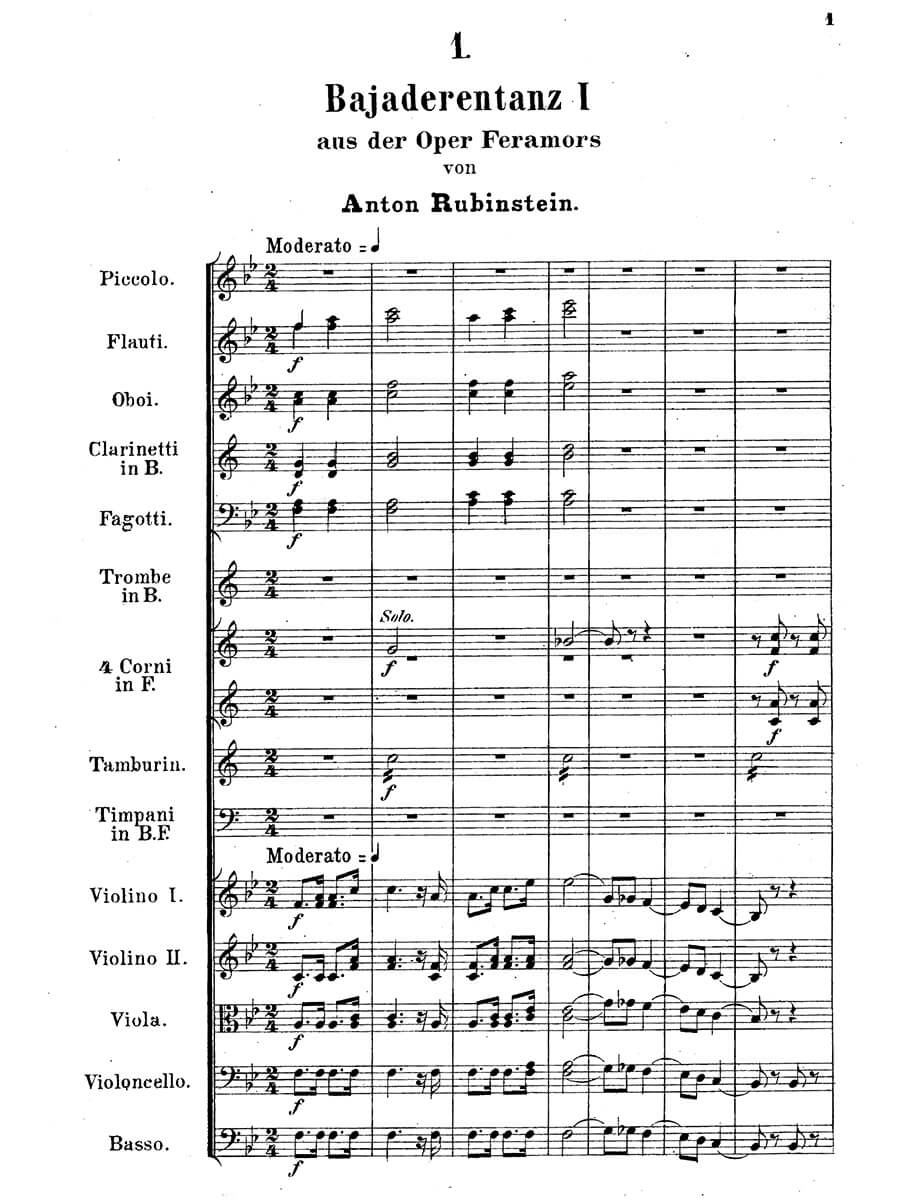Ballet Music and Wedding March for Orchestra from the opera ‚Feramors’
Rubinstein, Anton
33,00 €
Preface
Rubinstein, Anton – Ballet Music and Wedding March for Orchestra from the opera ‚Feramors’
(28 November [O.S. 16 November] 1829, Vykhvatintsy, Podolia, Russia[now in the Transnistria borderland of Moldavia, near the Ukraine] – 20 November [O.S. 8 November] 1894, Peterhof, Saint Petersburg, Russia)
Bajaderentanz I – 5:00, p. 3
Lichtertanz der Bräute von Kaschmir – 5:45, p. 24
Bajaderentanz II – 4:45, p. 57
Hochzeitszug – 3:45, p. 85
Ballet Music and Wedding March for Orchestra
from the opera Feramors (in Russian, Фераморс)
Dance of the Bayaderes I – 5:00, p. 3
Torchlight Dance of the Brides of Kashmir – 5:45, p. 24
Dance of the Bayaderes II – 4:45, p. 57
Bridal Procession – 3:45, p. 85
Publication
Leipzig: Bartolf Senff, 1863, plates 1286-1287.
Version for piano four hands by Richard Kleinmichel, plates 1200-09-1287.
Orchestration
2 flutes, piccolo, 2 oboes, 2 clarinets (B-flat and C), 2 bassoons, 2 trumpets
(in B-flat, D, F, and C), 4 horns in F, 3 trombones and tuba (in III/IV.), harp (in IV.), tambourine, timpani,
military percussion (snare drum, bass drum, cymbals, in III/IV.), and strings
Premiere of the opera
24 February 1863, Königlich-Sächsisches Hoftheater (Sächsische Hofoper-Semperoper, Dresden to a German libretto, written in Berlin by Julius [Levy] Rodenberg (1831-1914)
Composer
Best known as the founder of the St. Petersburg Conservatory, Anton Rubinstein was one of the great nineteenth-century keyboard virtuosos. The summit of his performing career was a series of seven consecutive “Historical Recitals” covering the history of piano music. He presented these throughout Eastern Europe and the United States as a “Steinway artist,” receiving as much as 200 dollars (in gold) per concert, plus all expenses. Each recital could feature as many as eight full piano sonatas, plus encores: they made powerful impressions on fellow pianists from Clara Schumann to the young Sergei Rachmaninoff. The first recital of each series included Baroque music from the seventeenth and eighteenth centuries by Byrd, Bull, Couperin, Rameau, Scarlatti, and Bach. In addition to virtuosity and an encyclopedic memory, he was praised for his tone, sensuous style of playing, and stamina: he gave a total of 215 American concerts in 239 days (sometimes as many as three per day), and he invested the proceeds in real estate near Saint Petersburg.
Anton Rubinstein was born 150 kilometers northwest of Odessa. His family converted from Judaism, and he was baptized when he was five, so he was raised in the Russian Orthodox faith, and then later became an atheist. He was educated in Moscow (1834-39) and Paris (1839-40), where he played for the composers Chopin and Liszt. After a three-year concert tour of Europe and a shorter tour of Russia, Anton (age fourteen) and his brother Nikolai (age eight) played for Tsar Nicholas I and the Imperial family at the Winter Palace in Saint Petersburg. From 1844-1846, both Rubinstein brothers were based in Berlin, where they were encouraged by Mendelssohn and Meyerbeer. By age seventeen, Anton knew he could no longer pass for a child prodigy, so he (unsuccessfully) sought the support of Liszt in Vienna and struggled to make a living from teaching in Berlin. After returning to Saint Petersburg due to the Revolutions of 1848, he performed and composed frequently for the Imperial Court, receiving substantial support from the Grand Duchess Elena Pavlovna, the Tsar’s sister-in-law. …
read more / weiterlesen … > HERE
Score Data
| Score Number | 4927 |
|---|---|
| Edition | Repertoire Explorer |
| Genre | Orchestra |
| Pages | 128 |
| Size | 210 x 297 mm |
| Printing | Reprint |
